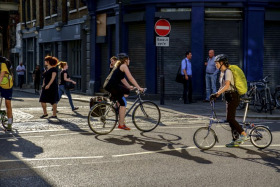- December 31st, 2022
- 0 Comments

After a recent article on "comprehensive transportation emission reduction planning" detailing the factors worth considering while many jurisdictions are developing plans to achieve ambitious greenhouse gas emission reduction targets through many ways (re: Transportation Demand Management and Smart Growth policies that reduce total vehicle travel), columnist Todd Litman reviews the role that active and micro modes like walking, bicycling, e-bikes and their variants, can play in reducing emissions.
Next month, Litman will present a paper at the Transportation Research Board annual meeting titled Evaluating Active and Micro Mode Emission Reduction Potentials. This article summarizes his key findings – ultimately that "most emission reduction plans significantly underinvest in walking, bicycling and micromodes compared with what is optimal."
Active mode improvements, he writes, can have leverage effects, so each additional mile of active travel reduces more than one vehicle-mile, in ways summarized in detail in the article – though quickly they are:
- Shorter active trips often substitute for longer motorized trips (think "local store" vs. "distant shops")
- Reduced chauffeuring as better walking/biking conditions reduce the need to chauffeur non-drivers and the empty backhauls (miles with no passenger) that result
- Increased public transit travel since most transit trips include walking and/or bicycling links
- Vehicle ownership reductions as active mode improvements allow some households to reduct their vehicle ownership and, in turn, additional vehicle trip generation
- Lower traffic speeds that often come with active travel improvements, in turn making non-auto travel more time-competitive with driving and reducing total automobile travel
- Walking and biking support more compact, multimodal communities by reducing the amount of land devoted to roadways and parking
- And as active travel increases, these modes more easily become the "social norm" or socially acceptable
The detailed article also includes links to reference material for all statistical data driving Litman's suggestions.
The study ultimately finds that most transportation emission reduction plans are biased in ways that tend to exaggerate electric vehicle benefits and undervalue active modes – assuming that active modes can provide only tiny emission reductions and overlooking the co-benefits that result when travelers drive less and rely more on non-auto modes, resulting in underinvestment in active modes compared with what is optimal.
For example, although commonly-cited statistics imply that active modes serve less than 2% of travel, more comprehensive analysis indicates that they actually serve 10-15% of trips, have significant and growing latent demand, often leverage additional vehicle travel reductions, and provide large and diverse benefits while also supporting other vehicle travel reduction strategies like public transit encouragement and compact community development.
Todd Litman is the executive director of the Victoria Transport Policy Institute, an independent research organization dedicated to developing innovative solutions to transport problems.














